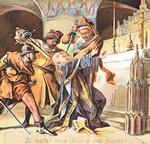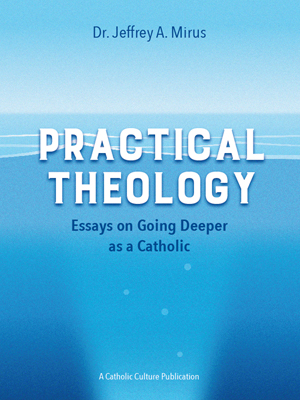Subscribe for free today!
Get newsletters with the latest content, and access to exclusive ebooks and podcast episodes.
Already subscribed? Log in to stop seeing invitations to subscribe.
November 2025 — Overview for the Month
Almost the entire month of November falls during the liturgical season known as Tempus per Annum or Ordinary Time (formerly Time After Pentecost), which is represented by the liturgical color green. Green is a symbol of hope, as it is the color of the sprouting seed and arouses in the faithful the hope of reaping the eternal harvest of heaven, especially the hope of a glorious resurrection. The liturgical color green is worn during the praying of Offices and celebration of Masses of Ordinary Time. The last portion of the liturgical year represents the time of our pilgrimage to heaven during which we hope for reward.
The last day of November is a Sunday and marks the beginning of Advent. The liturgical color changes to purple, representing a time of penance and preparation.
The Holy Father's Intentions for the Month of November 2025
For the prevention of suicide: Let us pray that those who are struggling with suicidal thoughts might find the support, care and love they need in their community, and be open to the beauty of life. (See also http://www.popesprayerusa.net/)
Feast Days for November 2025
1. ALL SAINTS, Solemnity2. ALL SOULS, Commem.
3. Martin de Porres, Opt. Mem.
4. Charles Borromeo, Memorial
9. Dedication of the Lateran Basilica, Feast
10. Leo the Great, Memorial
11. Martin of Tours; Veterans Day (USA), Memorial
12. Josaphat, Memorial
13. Frances Xavier Cabrini, Memorial
15. Albert the Great, Opt. Mem.
16. THIRTY-THIRD SUNDAY IN ORDINARY TIME, Sunday
17. Elizabeth of Hungary, Memorial
18. Basilicas of Peter and Paul; Rose Philippine Duchesne (USA), Opt. Mem.
21. Presentation of Mary, Memorial
22. Cecilia, Memorial
23. OUR LORD JESUS CHRIST, KING OF THE UNIVERSE, Solemnity
24. Andrew Dung-Lac and Companions, Memorial
25. Catherine of Alexandria, Opt. Mem.
30. FIRST SUNDAY OF ADVENT, Sunday
Focus of the Liturgy
The Gospels for the Sundays in November 2025 except the last, are from St. Luke, Cycle C, and the Weekdays follow Year I. November 30th marks the new liturgical year and is the First Sunday of Advent. The Gospels return to Cycle A, following St. Matthew's Gospel and the Weekdays follow Year II.
November 2nd | John 5:17-30: As the Father raises the dead and gives them life, so also does the Son give life to those whom he chooses. |
November 9th | John 2:13-22: Destroy this temple, and in three days I will raise it up. |
November 16th | Luke 21:5-19: By your perseverance you will secure your lives. |
November 23rd | Luke 23:35-43: Lord, remember me when you come into your kingdom. |
November 30th | Matthew 24:37-44: Stay awake, that you may be prepared! |
Highlights of the Month 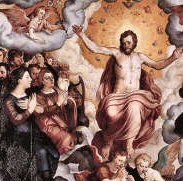 During November, as in all of Ordinary Time (Time After Pentecost), the Liturgy signifies and expresses the regenerated life from the coming of the Holy Spirit, which is to be spent on the model of Christ's Life and under the direction of His Spirit. As we come to the end of the Church year we are asked to consider the end times, our own as well as the world's. The culmination of the liturgical year is the Solemnity of Our Lord Jesus Christ, King of the Universe. "This feast asserts the supreme authority of Christ over human beings and their institutions.... Beyond it we see Advent dawning with its perspective of the Lord's coming in glory."— The Liturgy and Time, A.G. Mortimort
During November, as in all of Ordinary Time (Time After Pentecost), the Liturgy signifies and expresses the regenerated life from the coming of the Holy Spirit, which is to be spent on the model of Christ's Life and under the direction of His Spirit. As we come to the end of the Church year we are asked to consider the end times, our own as well as the world's. The culmination of the liturgical year is the Solemnity of Our Lord Jesus Christ, King of the Universe. "This feast asserts the supreme authority of Christ over human beings and their institutions.... Beyond it we see Advent dawning with its perspective of the Lord's coming in glory."— The Liturgy and Time, A.G. Mortimort
The month of November is very full of Memorials, feasts and solemnities. The main feast days are the:
Solemnity of All Saints (November 1),
the Commemoration of All the Faithful Departed (All Souls) (November 2),
the Feast of the Dedication of the Lateran Basilica in Rome (November 9), and
The Solemnity of Our Lord Jesus Christ, King of the Universe (November 24).
The other saint days are:
St. Martin de Porres (November 3),
St. Charles Borromeo, (November 4),
St. Leo the Great (November 10),
St. Martin of Tours, (November 11),
St. Josaphat (November 12),
St. Frances Xavier Cabrini (November 13)
St. Albert the Great (November 15),
St. Elizabeth of Hungary (November 17),
Presentation of Mary (November 21),
St. Cecilia (November 22),
and St. Andrew Dung-Lac and Companions (November 24)
St. Catherine of Alexandria (November 25).
The commemorations of Sts. Margaret of Scotland and Gertrude (November 16), Sts. Clement I and St. Columban (November 23) and St. Andrew (November 30) fall on Sundays and are superseded by the Sunday Liturgy.
Thanksgiving 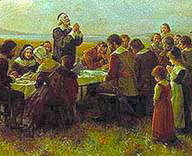 The national holiday (USA) of Thanksgiving also falls on the last Thursday of November. There are special Mass propers which may be used on this day. (Read more here.)
The national holiday (USA) of Thanksgiving also falls on the last Thursday of November. There are special Mass propers which may be used on this day. (Read more here.)
The tradition of eating goose as part of the Martin's Day celebration was kept in Holland even after the Reformation. It was there that the Pilgrims who sailed to the New World in 1620 became familiar with this ancient harvest festival. When, after one year in America, they decided to celebrate a three days' thanksgiving in the autumn of 1621, they went in search of geese for their feast. We know that they also had deer (a present from the Indians), lobsters, oysters, and fish. But Edward Winslow, in his account of the feast, only mentions that "Governor Bradford sent four men on fowling that so we might after a more special manner rejoice together, after we had gathered the fruit of our labours." They actually did find some wild geese, and a number of wild turkeys and ducks as well.
The Pilgrim Fathers, therefore, in serving wild turkeys with the geese, inaugurated one of the most cherished American traditions: the turkey dinner on Thanksgiving Day. They also drank, according to the ancient European tradition, the first wine of their wild-grape harvest. Pumpkin pie and cranberries were not part of the first Thanksgiving dinner in America, but were introduced many years afterward.
The second Thanksgiving Day in the New World was held by the Pilgrims two years later, on July 30, 1623. It was formally proclaimed by the governor as a day of prayer to thank God for their deliverance from drought and starvation, and for the safe arrival from Holland of the ship Anne.
In 1665 Connecticut proclaimed a solemn day of thanksgiving to be kept annually on the last Wednesday in October. Other New England colonies held occasional and local Thanksgivings at various times. In 1789 the federal Congress authorized and requested President George Washington to proclaim a day of thanksgiving for the whole nation. Washington did this in a message setting aside November 26, 1789 as National Thanksgiving Day.
After 1789 the celebration reverted to local and regional observance for almost a hundred years. There grew, however, a strong desire among the majority of the people for a national Thanksgiving Day that would unite all Americans in a festival of gratitude and public acknowledgment for all the blessings God had conferred upon the nation. It was not until October 3, 1863, that this was accomplished, when President Abraham Lincoln issued, in the midst of the Civil War, a Thanksgiving Proclamation. In it the last Thursday of November was set apart for that purpose and made a national holiday.
Since then, every president has followed Lincoln's example, and annually proclaims as a "Day of Thanksgiving" the fourth Thursday in November. Only President Franklin D. Roosevelt changed the date, in 1939, from the fourth to the third Thursday of November (to extend the time of Christmas sales). This caused so much consternation and protest that in 1941 the traditional date was restored."
—Excerpted from the Handbook of Christian Feasts and Customs, Francis X. Weiser
This item 12534 digitally provided courtesy of CatholicCulture.org


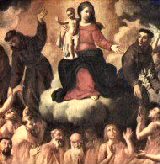
 November 26
November 26

 The crown refers to sanctity, the scrolls with the inscription Sanctus allude to the chant of the redeemed, "Holy, Holy, Holy." The left half of the shield indicates the brightness of the Heavenly life in contrast to the black right half and the trials of the earthly life.
The crown refers to sanctity, the scrolls with the inscription Sanctus allude to the chant of the redeemed, "Holy, Holy, Holy." The left half of the shield indicates the brightness of the Heavenly life in contrast to the black right half and the trials of the earthly life. This emblem, a heart with wings and pierced by a sword and suggestive of Mater Dolorosa, is a reference to the words of Simeon, "Yea, a sword shall pass through thine own soul also."
This emblem, a heart with wings and pierced by a sword and suggestive of Mater Dolorosa, is a reference to the words of Simeon, "Yea, a sword shall pass through thine own soul also."
 The only apparent reason for her to be known as the patroness of music is that St. Cecilia is said to have been skilled in singing the divine praises, oft accompanied by an instrument.
The only apparent reason for her to be known as the patroness of music is that St. Cecilia is said to have been skilled in singing the divine praises, oft accompanied by an instrument.  Patron of chastity and learning. The wheel set with spikes refers to that mentioned in the legend, which is said to have been broken by divine interposition, when persecutors attempted to break her upon it.
Patron of chastity and learning. The wheel set with spikes refers to that mentioned in the legend, which is said to have been broken by divine interposition, when persecutors attempted to break her upon it.  The patron of Russia, Scotland, and the Ecumenical Patriarchate. According to tradition St. Andrew was crucified on an X-shaped cross, known as a saltire of St. Andrew's cross, in Achaia.
The patron of Russia, Scotland, and the Ecumenical Patriarchate. According to tradition St. Andrew was crucified on an X-shaped cross, known as a saltire of St. Andrew's cross, in Achaia.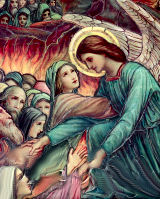 Requiem aeternam dona eis, Domine.
Requiem aeternam dona eis, Domine.